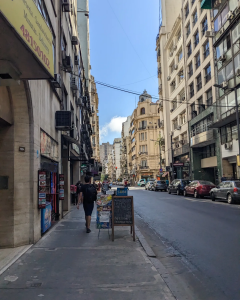Written by: Maddy Simpson | Spring 2023
ISEP Exchange in Buenos Aires – Universidad del Salvador
As I was preparing for my time here in Argentina,  I was constantly thinking about finances. How was I going to afford to live there? Was I going to run out of money? What if I get stranded somewhere and don’t have any cash? How was I going to exchange money?
I was constantly thinking about finances. How was I going to afford to live there? Was I going to run out of money? What if I get stranded somewhere and don’t have any cash? How was I going to exchange money?
However, after a couple of weeks here in Buenos Aires, I’ve adjusted to the different economic system. While I can’t use my debit card or Venmo like I’m used to, cash is easy to use and it’s easy to keep track of how much money I have. I’d like to acknowledge that while living in Argentina is cheaper for me because of a favorable exchange rate, that does not mean that the same is true for the Argentines who live here. Every day, Argentines face higher and higher inflation which makes budgeting difficult and makes necessary goods cost twice as much in a year. Here are some examples of how this has affected daily life in Argentina:
- The Exchange Rate(s)
In Argentina, there are two exchange rates. The first is the Red exchange rate. This is the official exchange rate set forth by the government’s central bank. This is the rate that you’ll see when you look it up online. The second rate is the Blue rate. This rate is an unofficial rate that changes more frequently and more accurately represents the current exchange rate.
When I was preparing for Argentina, I was told to wait to exchange my money until I got there so that I could use the blue rate and get more pesos for my buck. One of the first things I did after I arrived at my homestay was go to the exchange shop to exchange my money. At the shop, I got 366 pesos per dollar. If I had gone to the bank to exchange my money, I would have only gotten 170 pesos per dollar.
Almost all business in Argentina is done in cash, from buying lunch to paying the guy who comes to fix the sink. Even when using services like Uber, you can opt to pay in cash. Many Argentines are reluctant to store their money in the bank because they don’t trust it. So they’ll hide their money in a safe place at home, often in US Dollars. Then they’ll take out what they need for the day, convert it, and carry on.
3. Prices
When you first look at prices in Argentina, you may be shocked to find that a simple Big Mac costs $1800. But don’t worry, that is a reasonable price for a good meal in Argentina. Inflation has led to higher and higher prices in Argentina with the peso valuing less and less. The cheapest product I’ve seen during my time here cost 25 pesos. Argentina has a cent (called the centavo), but inflation has made prices so high that it’s almost never used.
Not only are prices high, but they change frequently. It’s not unusual to be handed a menu with prices crossed out and changed. A coffee that cost 540 pesos this week may cost 620 pesos next week.
4. Installment Plans aka Cuotas
It’s not uncommon to see signs outside of stores advertising payment plans for larger items, like bedding sets or expensive new shoes. These items can cost thousands of pesos and most people don’t have the full amount on hand. So, it’s not uncommon for people to set up monthly payments to make the purchase more reasonable.
Because most business is done in cash using larger bills, most stores prefer exact change. But if something comes out to 566 pesos, the store will simply round down to 560 pesos. Some stores will even give discounts if you don’t have exact change. For example, I bought something that cost 520 pesos, but I didn’t have any smaller denominations, so I only paid 500 pesos.
While it definitely took a little getting used to, I’ve adapted to the Argentine economic system. Like all of my experience here, all it took was the first step and some practice. While I don’t know exactly what these next 3 months will be like, I’m looking forward to all the new things I’ll get to experience. My advice to you future exchange students is this: Do some research and take that first step. It’ll turn out okay.


